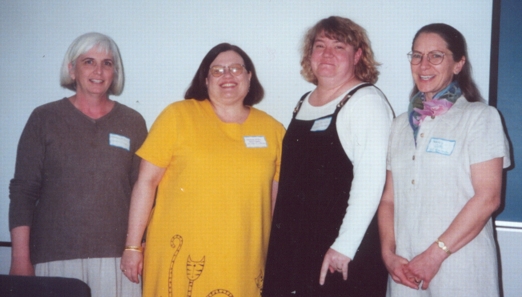
Panelists (left to right): Rosemary McGill (CSU-Fullerton), Barbara Miller (CSU-Fullerton), Amy Wallace (Claremont), Nancy Getty (UC-Riverside)
1. Amy Wallace (Claremont): Claremont has a flexible instruction team of four to six librarians. An Active Learning Consultant from the Claremont colleges was brought in to observe sessions and make suggestions for "lecture-free learning." Librarians had been beginning sessions with twenty minutes of lecture, then giving students activities. The consultant suggested using warm-up exercises which drew on students' previous knowledge to harness their nervous energy. Focus groups of students were also convened: students wanted small-group exercises with shared computers, where librarians circulate to offer help. Students are asked to begin warm-up activities immediately, even before introductions. The warm-up activities are then brought into exercises which lead students through the research process, but can be customized to their own research. Activities emphasize concepts, not mechanics, which can be covered through one-on-one interaction during the session. A packet of sample activities was circulated: attendees may modify these for their own use. To teach this way, the librarian must "let go of the small stuff" and not try to cover everything.
2. Nancy Getty (UC-Riverside): In the past, classes began with a twenty minute lecture followed by exercises. Nancy decided that the problem was that "the most important three things" to cover change depending on students and assignments. She developed problem-based exercises to individualize the sessions more. Students are given a choice of four topics and instructed to begin at the library web page. The assignment is specific regarding types of resources, but includes no specific directions. Students work in small groups, set up so they can mentor one another. Each group appoints a reported and keeps track of research steps for twenty minutes. The groups then report to the class. The librarian does not interrupt reporters, except to provide help when major errors occur: "let the details go!" This approach has the added benefit of providing feedback regarding library web page design.
3. Rosemary McGill and Barbara Miller (CSU-Fullerton): In the Fullerton First-Year Program, 150 freshmen come to the library once a week for four weeks for instruction. Each librarian involved had two classes, which were co-taught by a set of other librarians. Librarians added a Blackboard Course Info component last year, first to post grades and the final exam, then more broadly to facilitate communications between students and librarians. Some successful components were "Questions About Last Week" and online quizzes. Online activities got the students focused. Students liked Blackboard, but there were many sign-in glitches and a lack of IT support.
One activity asked students to discern between scholarly and popular articles. Originally, students examined physical copies of journals. Other groups were asked to examine copies of the same articles from a full-text database (Expanded Academic ASAP). Some students hated working in groups. Most were interested in aesthetics and currency of articles over other criteria. Groups presented to the class, and librarians learned not to interrupt. One problem was that this instruction was not "point of use:" those who have course assignments are more able to understand key concepts. Students hated interruptions in report. Not point of use, those who have assignments in other classes comprehend more.
Questions and Answers:
Q: What about places where specifics are important (descriptors, explode, etc.)?
A: Design active learning exercises to explore these key concepts.
Q: What about teaching multiple dbs?
A: Have groups work in a few different dbs. Try giving out a checklist of
different database features to take home.
Q: How has active learning affected assessment?
A: At Claremont, satisfaction levels from faculty and students are up, but it's
hard to administer a quantitative assessment tool. Librarians need to
work with individual instructors to accomplish this. Claremont is seeing
a rise in reference usage, and the quality of student questions has changed.
Submitted by Sarah McDaniel, sarahmcd@usc.edu , University of Southern California, Leavey Library